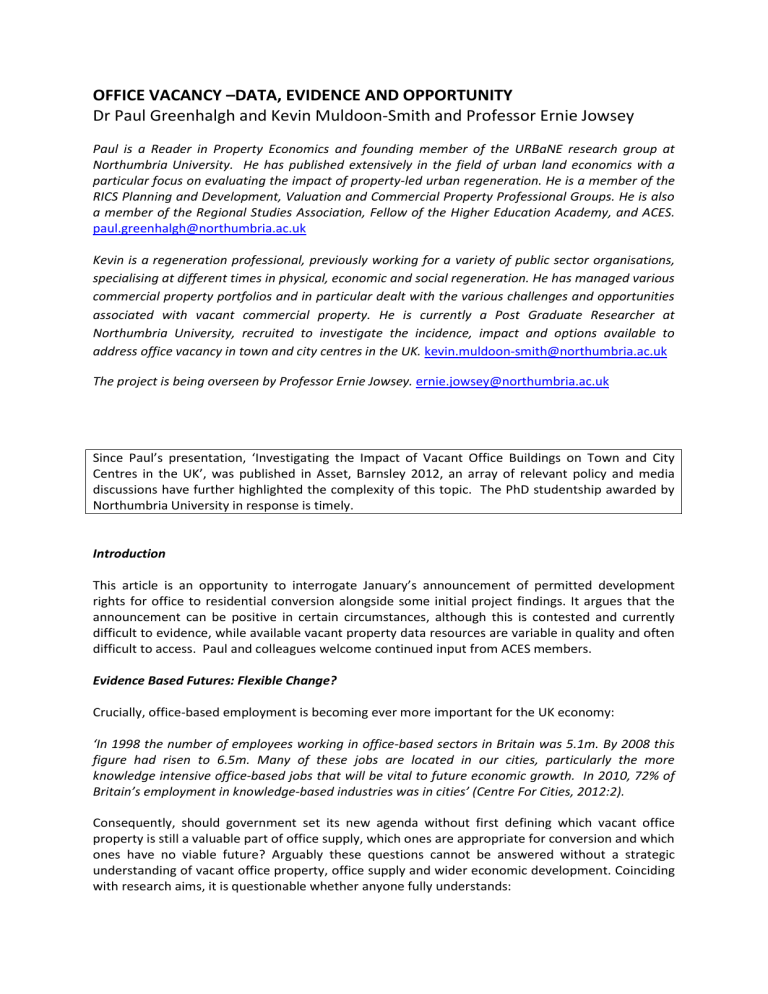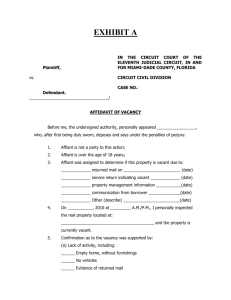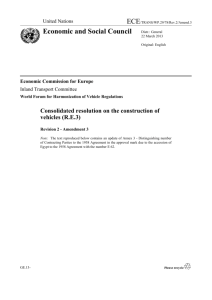Office Vacancy: Opportunities and Challenges
advertisement

OFFICE VACANCY –DATA, EVIDENCE AND OPPORTUNITY Dr Paul Greenhalgh and Kevin Muldoon-Smith and Professor Ernie Jowsey Paul is a Reader in Property Economics and founding member of the URBaNE research group at Northumbria University. He has published extensively in the field of urban land economics with a particular focus on evaluating the impact of property-led urban regeneration. He is a member of the RICS Planning and Development, Valuation and Commercial Property Professional Groups. He is also a member of the Regional Studies Association, Fellow of the Higher Education Academy, and ACES. paul.greenhalgh@northumbria.ac.uk Kevin is a regeneration professional, previously working for a variety of public sector organisations, specialising at different times in physical, economic and social regeneration. He has managed various commercial property portfolios and in particular dealt with the various challenges and opportunities associated with vacant commercial property. He is currently a Post Graduate Researcher at Northumbria University, recruited to investigate the incidence, impact and options available to address office vacancy in town and city centres in the UK. kevin.muldoon-smith@northumbria.ac.uk The project is being overseen by Professor Ernie Jowsey. ernie.jowsey@northumbria.ac.uk Since Paul’s presentation, ‘Investigating the Impact of Vacant Office Buildings on Town and City Centres in the UK’, was published in Asset, Barnsley 2012, an array of relevant policy and media discussions have further highlighted the complexity of this topic. The PhD studentship awarded by Northumbria University in response is timely. Introduction This article is an opportunity to interrogate January’s announcement of permitted development rights for office to residential conversion alongside some initial project findings. It argues that the announcement can be positive in certain circumstances, although this is contested and currently difficult to evidence, while available vacant property data resources are variable in quality and often difficult to access. Paul and colleagues welcome continued input from ACES members. Evidence Based Futures: Flexible Change? Crucially, office-based employment is becoming ever more important for the UK economy: ‘In 1998 the number of employees working in office-based sectors in Britain was 5.1m. By 2008 this figure had risen to 6.5m. Many of these jobs are located in our cities, particularly the more knowledge intensive office-based jobs that will be vital to future economic growth. In 2010, 72% of Britain’s employment in knowledge-based industries was in cities’ (Centre For Cities, 2012:2). Consequently, should government set its new agenda without first defining which vacant office property is still a valuable part of office supply, which ones are appropriate for conversion and which ones have no viable future? Arguably these questions cannot be answered without a strategic understanding of vacant office property, office supply and wider economic development. Coinciding with research aims, it is questionable whether anyone fully understands: where the vacant office property is how much vacant office property exists what types of office building are most likely to be vacant what types of office property have viable futures in either their present or alternative use Without this information, how can practitioners and policy makers know if there is a correlation between those properties, that are long term vacant, and those that are most suitable for conversion? Does the permitted development announcement make sense in such circumstances? Does fear of unknown repercussions explain why there have been so many exemption requests from local authorities? How does this perceived incentive co-ordinate with empty property rate exemptions for new build office property but not existing/second hand property? Consequences of long term vacant office property have been well rehearsed, such buildings display a combination of economic, functional and physical obsolescence, refurbishment opportunities are difficult to fund in the prevailing weak market conditions. Such buildings generate negative externalities: they overhang the local property market and suppress values and investment; they cause visual blight in their immediate surroundings; they represent high embodied energy from their production and a waste of resource, both in terms of capital investment, holding costs and land use. Illustrating this in 2012, Centre for Cities, in their report “Making the Grade” argued that there has been a mismatch in recent years between the demand for office space and supply of it, suggesting that: ‘the supply of office space is not supporting the expansion of some of our most successful cities. As businesses look to upgrade to Grade A office space, they leave an increasing amount of Grade B space unoccupied’ (CFC 2012:29). If developers can see the potential returns associated with refurbishing existing space or the council can change its use, then the cyclical nature of the property market will continue to follow the business cycle (CFC 2012:29). However, if this space cannot be refurbished or alternative uses found then the city will face an ever increasing number of obsolete offices which, if not dealt with, will retard the quality and value of the built environment, making it less attractive to businesses, workers and residents’ (CFC 2012:29). Can government and its agencies intervene to encourage the property market to follow the business cycle? Lessons can be learned from New York and Los Angeles (Beauregard 2005, Bullen and Love 2009) where successful attempts to tackle vacant office property have been detailed utilising a mixture of redevelopment incentives. They explain that once relevant economic conditions improved, demand for office increased and some office to housing conversions were returned to office use. These findings point toward the need for flexible redevelopment proposals and initial design proposals for new buildings which allow flexibility in response to changing market conditions. All of these issues cry out for a reliable and flexible vacant office based information system which evidences the viable supply of appropriate office space in the UK, ensuring that cities with the potential to support jobs and business growth are not restricted by a lack of suitable office space and those cities with redundant office space can respond to the challenges that ensue, understanding which properties have a viable future in either their present or alternative use. Creation of a redundant office building typology (OBT) and redundant office building solution model (OBSM) will attempt to inform the responses to these questions. The following section details some of the initial challenges associated with accessing and making sense of vacant office property data resources. Vacant Office Property: Understanding Data and Accessibility Burdett (1998) referring to the 1990s property recession argues that the hangover of the 1960s and 1970s building boom should be viewed constructively: ‘redundant offices represent an opportunity to re-invent the way business and residential accommodation is provided in the centres of Britain's cities. Today's uncertainties should not prevent us from taking researched risks to provide what the emerging markets of the next century need’ (Burdett 1998:39). The first phase of this research utilises existing data resources to understand the nature, scale and extent of vacant office property in town and city centres. It is interesting to reflect on progress in this regard. Does the inverse relationship, defined by Currie and Scott (1991) between complex property markets and the data available to analyse them, still exist? Data access, conformity, comparability and transferability all pose problems; many existing data sources were created for separate purposes and at different times, which makes strategic understanding of vacant office property difficult to develop, and in time, disseminate to enable researched risks. Information regarding vacant office property does exist, but rarely goes beyond regional and local government boundary level, making hereditament based analysis impossible. The Homes and Communities Agency manages the National Land Use Database (NLUD) which collates information from local authorities regarding previously developed land and premises. However this information is only collected on a site basis making it difficult to focus on actual buildings and their associated characteristics. The Valuation Office Agency (VOA) publishes useful building attribute information; in May 2012 it published an experimental statistic, covering 2000-2012, regarding floor space and rateable value for a range of bulk classes liable for business rates for each local authority. This statistic highlights the difficulty in comparability between different data sets. It cannot be compared with the Department for Communities and Local Government (DCLG) Commercial and Industrial Floor space statistic, which was compiled until 2009, or data which is available via the Neighbourhood Statistics application at the Office for National Statistics for 1998-2008, which details information on a variety of non–domestic property, including total floor space, rateable value and rateable value per sq m, at the Medium Super Output Area (MSOA), Local Authority District (LAD) and Government Office Region (GOR). The 2012 statistic includes backdated assessments, historical data does not. The methodologies for processing the floor space data are different and new classifications have been designed with regard to user needs and operational practices in recording data. Crucially, these data sets do not deal with specific commercial property vacancy. The valuation of property by the VOA doesn’t account for vacancy as it is deemed to have no bearing on rateable value. Historically DCLG published a vacancy rate for each LA between 1998 and 2005; this was produced as an overall estimate of the value of empty property as a proportion of the total value of property. Katyoka and Wyatt (2008) argue that this statistic’s primary aim was not to measure vacancy, rather tax; it therefore has presumptions that detract from its accuracy. In 2004, Myers and Wyatt argued that government systems often exacerbate the problem of measuring vacancy, with data never collated to evidence the complete picture. Arguably, little has changed over the last decade. In an attempt to remedy this problem Myers and Wyatt (2004) created an experimental statistic for vacant property. Utilising the VOA rating list supported by the Rating Support Application (RSA) and local authority property taxation information, they arrived at a composite statistic, defining vacancy within local authority areas. The RSA contains various building descriptors such as physical description, age, floor space and post code for each premises surveyed. Business rate returns, collected by local authorities for central government use detail commercial property vacancy at hereditament level, when both of these resources are combined a picture of vacancy at individual hereditament can be defined. In 2006 the DCLG published a technical report regarding development of commercial and industrial property vacancy statistics detailing how vacancy statistics could be improved by working with local authorities to collate extra information. This method was piloted in Leeds, leading to initial hereditament based vacancy statistics, however it has never been extended beyond the experimental or initial geographic area due to lack of resource and difficulty in analysis. This study has assessed the viability of using this method, unfortunately the RSA is not available to the public and the VOA is not currently in a position to release the attribute based information, although it does exist. More positively, during pilot investigations, the study has gained up to date vacancy records for around 100 local authorities utilising vacant property non-domestic rate returns (NNDR), in most cases for either 2011 or 2012, representing about a third of England and Wales. Other local authorities’ information was either out of date, not in an appropriate format or not released due to lack of resource, confidentially or ‘likelihood of crime’! Although NNDR returns give an accurate description of vacancy they do not contain building descriptors. Commercial information resources such as Estates Gazette and Co-Star are being utilised to create building attribute profiles. Difficulty accessing data via the VOA and local authorities highlights another ACES concern: the current Local Government Transparency consultation. In general this points toward the difficulty in promoting holistic intervention in urban areas, with data not readily available to support analysis to inform effective policy formulation and implementation. Progress: Evidence based decisions? Some efforts have been made, at both international and domestic levels, to understand and tackle the issue of vacant office property. The European software project, TOBUS (Tool for Selecting Office Based Upgrading Solutions), illustrates how this could happen with specific regard to functional obsolescence when assessing office conversion. The method can be used for an overall assessment and diagnosis of the existing condition of office buildings, the evaluation of various refurbishment and retrofit scenarios and cost of induced works, in the preliminary stages of a project (Allehaux and Tessier 2002, Balarus 2002). Kincaid (2000, 2002) in response to the 1990s property recession, demonstrates via an analysis of demand and supply variables how buildings can be adapted in response to changing patterns of demand and how new office buildings should be developed to support a variety of uses and functions. He argues that a degree of redundancy, use ambiguity and flexibility within a permissive and dynamic regulatory system, could lead to more adaptable and sustainable futures for facilities, buildings and infrastructure. He further argues that it is no longer reasonable to assume that new building stock will remain in its original use class. Adaptive re-use may soon become the norm rather than the exception. In 2011, Decentralisation and Planning Minister Greg Clark (2011) advocated permitted change: ‘Patterns of office use have changed as employers prefer large open plan spaces to individual offices and as more and more people work from home. That has meant that there are many offices that have been vacant for years". But is it feasible to change office layouts? Abstract Group chief executive, Mark Glatman (2012), responsible for Ruskin Square’s Renaissance development in Croydon, has questioned the financial viability of upgrading old offices, warning that, much of Croydon’s old stock is only fit for demolition and should not be reused. Robert Peto (2013) illustrates the continuing problem of vacant office property, arguing that the vacant office problem will continue to enter the market, largely unfinanceable, as leases continue to shorten and rental values gain further downward pressure. Ominously the Greater London Authority (2013) has warned that new rules, that would allow offices to be converted to homes without the need for planning permission, could potentially result in the loss of up to 340,000 jobs in central London. Clearly the future of redundant office stock is contested; not all office buildings can be viably converted into housing or any other use. What will happen to those buildings with no viable future and how do we make best use of permitted development rights for those properties that do have a viable future? Unfortunately there is no detailed evidence base to support these arguments or answer these questions. Development of a vacant office building typology (OBT) and vacant office building solution model (OBSM) offers the prospect of robust evidence based solutions. In time this may be combined with Building Information Modelling (BIM) to understand the best futures for vacant office properties. This project is only in its infancy but we are always on the lookout for partners to work with and more data is always welcome. Ultimately the OBT and OBSM will only be as robust as the data that goes into them. We welcome ACES members’ continued support in developing this resource. Just as importantly we wish to maximise collaboration with ACES and would like to understand what ACES members would like to see included in the study (Kevin will be pursuing this - contact details above). The next few months will see some real change and progress in the subject area and research programme. By the end of the autumn we should know government response to LAs’ request for exemptions. With the Government indicating that exemptions will only be granted in exceptional economic circumstances, how do LA’s intend to demonstrate that their circumstances are exceptional? Perhaps this research project may be able to provide some evidence to inform decision making. Bibliography Allehaux D.; Tessier P. (2002) Evaluation of the functional obsolescence of building services in European office buildings, Energy and Buildings, Volume 34, Number 2, February 2002, pp. 127133(7), Elsevier. Balaras, C. (2002). "TOBUS - A European method and software for office building refurbishment," Energy and Buildings 34: 111-112. Beauregard, R.A. (2005), “The textures of property markets: downtown housing and office conversions in New York City”, Urban Studies, Vol. 42 No. 13, pp. 2431-45. Bullen, P & Love, P (2009) Residential regeneration and adaptive reuse: learning from the experiences of Los Angeles, Structural Survey, Vol 27, No 5, Emerald Group Publishing Group. Burdett, T (1998) Property Management Market Review "Redundant offices", Property Management, Vol. 16 Issue 1. Centre for Cities (2012) Making the Grade The impact of office development on employment & city economies, Joe Sarling, Paul Swinney & Ken Coupar, British Council for Offices. Clark, G (2011) Increasing the number of Available homes Consultation, Department for Communities and Local Government 8 April 2011 https://www.gov.uk/government/news/growthplan-to-transform-empty-offices-into-new-homes. DCLG (2006) Technical Report: Development of commercial and industrial property vacancy statistics Glatman, M (2012) Develop Croydon Conference. Tuesday 27 November. Katyoka, M & Wyatt, P (2008) An investigation of the nature of vacant commercial and industrial property, Planning Practice and Research, 23 (1), pp. 125-145. Kincaid,D.(2000) "Adaptability potentials for buildings and infrastructure in sustainable cities", Facilities, Vol. 18 Issue 3/4, pp.155 – 161. Kincaid, D. (2002) Adapting Buildings for changing uses: guidelines for change of use and refurbishment, London, Spon Press. Lett, J (2013) London Assembly Planning Committee: 11 March 2013.Greater London Authority. Myers, D. and Wyatt, P. (2004) Rethinking urban capacity: identifying and appraising vacant buildings, Building Research & Information, 32(4), 285-292. Peto, R (2013) Dealing with Debt, RICS, Commercial Property Journal. February/March 2013.





